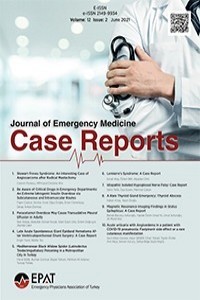Paracetamol Overdose May Cause Transudative Pleural Effusion in Adults
paracetamol, acetaminophen, over dose, pleural effusion,
___
- 1. David Josephy P. The molecular toxicology of acetaminophen. Drug metabolism reviews. 2005;37(4):581-94.
- 2. Papazoglu C, Ang JR, Mandel M, Basak P, Jesmajian S. Acetaminophen overdose associated with double serum concentration peaks. Journal of community hospital internal medicine perspectives. 2015;5(6):29589.
- 3. Duran L, Sisman B, Dogruel C, Yardan T, Baydin A, Yavuz Y. Parasetamol Zehirlenmesinde Intravenöz N-Asetil Sistein Kullanimi/Use of Intravenous N-Acetyl Systein in Paracetamol Intoxication. Journal of Academic Emergency Medicine. 2011;10(4):145.
- 4. Lancaster EM, Hiatt JR, Zarrinpar A. Acetaminophen hepatotoxicity: an updated review. Archives of toxicology. 2015;89(2):193-9.
- 5. Mazer M, Perrone J. Acetaminophen-induced nephrotoxicity: pathophysiology, clinical manifestations, and management. Journal of medical toxicology : official journal of the American College of Medical Toxicology. 2008;4(1):2-6.
- 6. Zarogiannis SG, Kalomenidis I. Can pharmacologic agents speed the rate of resorption of pleural fluid? Current opinion in pulmonary medicine. 2015;21(4):372-5.
- 7. Porcel JM, Light RW. Diagnostic approach to pleural effusion in adults. Am Fam Physician. 2006;73(7):1211-20.
- 8. Moschos C, Kalomenidis I. Drug Related Pleural Disease. TTD Plevra Bülteni. 2010;4(3):8-18.
- 9. Huggins JT, Sahn SA. Drug-induced pleural disease. Clinics in chest medicine. 2004;25(1):141-53.
- 10. Kossick MA. Intravenous acetaminophen and intravenous ketorolac for management of pediatric surgical pain: a literature review. AANA journal. 2014;82(1):53.
- 11. Jones VM. Acetaminophen injection: a review of clinical information. Journal of pain & palliative care pharmacotherapy. 2011;25(4):340-9.
- 12. Lai-Fook SJ. Pleural mechanics and fluid exchange. Physiological reviews. 2004;84(2):385-410.
- 13. Kouritas VK, Zisis C, Bellenis I, Gourgoulianis KI, Molyvdas PA, Hatzoglou C. Nonsteroidal anti-inflammatory drugs alter the human mesothelial pleural permeability via ion cellular transportation by inhibiting prostaglandin synthesis. Respiration; international review of thoracic diseases. 2012;84(1):62-8.
- 14. Kouritas VK, Magkouta S, Zisis C, Psallidas I, Gourgoulianis KI, Kalomenidis I. Paracetamol and ibuprofen block hydrothorax absorption in mice. European journal of cardio-thoracic surgery : official journal of the European Association for Cardio-thoracic Surgery. 2015;47(3):426-30; discussion 30.
- Yayın Aralığı: 4
- Başlangıç: 2010
- Yayıncı: Alpay Azap
Sevil ALKAN ÇEVİKER, Alper ŞENER, Cihan YÜKSEL, Taylan ÖNDER, Anıl AKÇA, Servan VURUCU, Safiye GÜÇLÜ
Cosmin FLORESCU, Christine AHN
İlker AKBAŞ, Abdullah Osman KOCAK, Sibel GÜÇLÜ UTLU, Sinem DOĞRUYOL, Zeynep ÇAKIR
İsmail ATAŞ, Özlem BİLİR, Alpaslan ÜNLÜ, Filiz TAŞÇI
Fikret BİLDİK, Burhan ÇOMRUK, Başak YÜKSEK, Mehmet Ali ASLANER, Tuncay TÜRKEŞ
Selim TETİK, Oya GÜVEN, Mehmet ÇOBAN
Berrak BARUTCU ASFUROĞLU, Yaprak Özüm ÜNSAL, Umut ASFUROĞLU, Ali Murat KOC
Figen COŞKUN, Sevilay VURAL, Oğuz EROĞLU, Ertan CÖMERTPAY, Şenay ARIKAN DURMAZ
